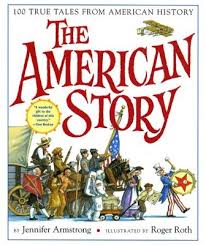The American Story
Listen to the Recess! Clip
| Author | John Cech |
| Air Date | 10/11/2006 |

The American Story Transcript
You wouldn’t know it today, to judge by all the tourists and traffic, but St. Augustine, Florida, just a short morning’s drive from Gainesville, where we produce these programs, lays claim to the title, First City in America. First European city, that is, because, as we know, there were plenty of other Native American cities before 1565 when Pedro Aviló first sailed into what is now St. Augustine harbor and claimed the whole of whatever might be la Florida for Spain.
The story of St. Augustine is the first chapter in Jennifer Armstrong’s new book, The American Story. This large volume is an engrossing collection of a hundred short narratives that weaves together a fabric of tales about both important and little known events of American history. Did you know, for instance, that the first European baby born in New England was named Peregrine? Or that the first democracy on this continent was not the one that the colonists hammered together after the Revolutionary War, but rather the constitution that the Iroqouis, Mohawk, and other tribes forged in 1390? And did you know that one of the first organized revolts against tyranny did not occur in the late 1700s, but rather a century earlier, when the Pueblo people of New Mexico threw off the yoke of Spanish rule?
This book is brimming over with these and other rare shards of our national history. Few are more than four pages long, with spot and full page water color illustrations by Roger Roth. And through Armstrong’s sure, clear prose, all of these tales have a fresh, mythic energy to them, even when they are about the familiar figures and events that have and continue to shape our cultural consciousness. This approach works because Armstrong tells these events as stories and not as dry lessons or exemplary fables. Instead, George Washington falls asleep during a portrait sitting. We learn that Uncle Sam was a purveyor of meat for the government during the War of 1812. And we discover that the subject of Dorothea Lange’s world famous photograph of an unnamed migrant mother during the Great Depression was really Florence Armstrong and her children, who had escaped the choking dust of Oklahoma and were picking peas and living in a tent in California. The American Story ends with the 2000 presidential election, but Armstrong could well go on, and on, and on — through other volumes, other tales, other accounts of the events, large and small, that compose the mosaic of our national memory. One feels that she has just begun the story.
SHARE
Share this content on these platforms.